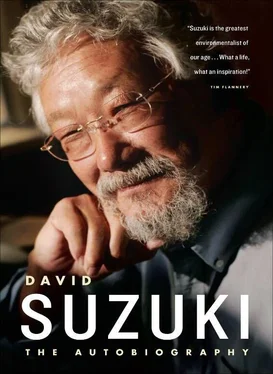After the Altamira protests, the Brazilian government was worried about troublemakers who might make contact with Indians and get them all stirred up. We heard an edict might have been passed requiring anyone wanting to visit an Indian village to first apply for permission. We knew we would never be approved, so we decided to ignore it and go in without official permission. We flew to Redenção, a rough-and-ready frontier town where we had to find the plane we had bought and a pilot to fly it.
The pilot we found flew us across the river and then mysteriously landed the plane on a road, where he got out and walked away. He reappeared with his girlfriend, who made one more person than the aircraft could handle, so one of us had to be let off. Miles gallantly offered to stay behind in Redenção, and although the pilot promised to pick him up the next day, it was a pretty courageous decision. I had flown into Aucre not speaking a word of Portuguese, but at least I had Paiakan as a friend; Miles knew no one and ended up using sign language to the few Indians who were around. He reached the village, found a place to stay, had a meal, and got back out to meet the plane next day.
After we left Miles, we flew over a sea of unbroken green for almost an hour before an opening in the forest canopy appeared, revealing the circle of huts I had visited just under a year before. We were a great curiosity to the Kaiapo, especially our two daughters. Two young boys hauled our bags as we were led to an empty hut and told we could hang our hammocks there. When it became clear that we didn't have a clue how to hang a hammock, the villagers dissolved in laughter. It was the first of many amusements our ignorance provided the community.
Like all the other huts, the one that was to be our home for two weeks was made of mud plastered between vertical sticks and had a thatched roof. The floor was dirt, and soon everything was covered in a layer of red dust. The children, most of them naked except for strings of beads around their necks, wrists, and ankles, crowded around to watch our every move as we unpacked our bags.
Soon we were invited to Paiakan's hut, which was next to ours, and treated to a meal of fish, beans, and rice. Sev and Sarika were happy to be back with their friends Oe and Tania, who took them out to see the river nearby. We learned to spend hours in that pool during the heat of the day and never once even felt a piranha; Paiakan assured us these fish were only a problem if water levels dropped — and they are delicious to boot.
We went to sleep that night refreshed by dips in the river, well fed, and only anxious for Miles to join us, which he did next morning. We had brought mosquito nets to wrap around the hammocks, as well as light sleeping bags for the early morning cold. After a couple of days of struggling with the netting, we gave up, as there weren't a lot of mosquitoes and Paiakan assured us it was the farmers and miners from cities who brought the malaria with them.
Each morning we woke up to find a row of faces staring at us. Children (and sometimes adults) would sit along the walls just watching — I guess we were their equivalent to early morning cartoons. All of our possessions were on the ground or in open bags and we never lost a thing, though we had many coveted items; everyone was delighted when we gave away much of our stuff before we left because it was too heavy for the plane.
We had to gather fresh food every day, a great experience for us because that meant we spent most of our time fishing. The first day, Paiakan took only Miles and me on a fishing expedition in the dugout canoe. But the females in our gang were very unhappy and demanded they be included. From then on, they were, although none of the women from the village accompanied us.
The Kaiapo were amused by my collapsible rod and tiny Seiko reel with four-pound test line, because my fishing gear was too light for the fish I might hook. I figured I'd show them; after all, a good fisherman is supposed to be able to land huge fish by playing them to exhaustion. On our first trip, I assembled the rod, put on a spinner, and cast into the murky water. Blam, ping . A fish hit and snapped the line. The tension was too tight, so I adjusted it, tied on another spinner, and cast— blam, ping : same thing. Hmm. The Kaiapos' eyes were crinkling in amusement, and when I cast for the third time and the same thing happened, the Kaiapo were roaring. Thank goodness they didn't know how to say in English “I told you so.” So much for “civilized” technology, although they themselves did use nylon lines and metal hooks.
When I finally hooked a tucunare, that incredible fighting fish snapped my rod in two! I wasn't going to let it get away and began pulling in the line by hand, when wham, an arrow impaled my catch right behind the gills. I was too busy fighting the fish and hadn't noticed Paiakan as he raised his bow and shot an arrow. As far as I was concerned, I caught the fish. . well, I hooked it, anyway.
Each time we made a trip, Paiakan took along Caro, a boy of about six. Caro would hand tools to Paiakan, jump out of the canoe to pull it to shore, or follow him into the forest to gather bait. He was obviously being taught in the very best way.
The river, Rio Zinho, was a wonder, narrowing to a swiftly flowing channel, widening out into long, deep pools, or becoming shallow with long riffles, each area containing a different array of fish. One day we paddled down the river to a wide, shallow area with rocks sticking out of the water. Paiakan got out with his bow and very long arrows. He carefully walked from rock to rock, staring into the clear water, and finally shot. The arrow had struck something. It waved about until eventually Paiakan carefully lifted an immense, snakelike fish from the water. It was an electric eel, capable of delivering a hefty electrical wallop that could be fatal to a small child.
Paiakan clubbed it repeatedly, then, making sure it didn't touch him or any of us, laid it in the bottom of the canoe. I don't know how long the dead animal takes to discharge its biobatteries, but it was quite a while before Paiakan touched it. The fish must have been close to six feet in length and four inches in diameter, and when Paiakan cut into it, I saw the flesh was milky white. Apparently it is a highly prized delicacy, but we didn't try any as it was divided among the elders of the village.

Paiakan (right) lifting an electric eel while Mokuka dispatches another one.
That's me on the top left, with Caro.
On one trip upriver, we came to a large, deep pool that must have been a hundred yards long and perhaps ten or more feet deep. We couldn't see the bottom. Paiakan drove the canoe into reeds along the bank and leaped out, accompanied by Caro. After a few minutes of thrashing and splashing, they emerged with a string of fish, each about six inches long. These, it turned out, would be the bait. They tied sixteen-foot lengths of thick line, with a large hook on one end of each, around pieces of wood that would act as floats. As we pushed off, Paiakan hooked a fish on each line and tossed the floats into the water as we continued upriver.
Hours later, on our way home, we came back through the pool and saw several of the floats buzzing around as if they were motorized. Beautiful catfish were hooked on the lines. And they too were delicious.
One of our longest trips was an all-day venture downriver. We would pull ashore to eat and then drift down. Paiakan had a small motor on his boat but only a tiny can of fuel, and I worried about getting back upriver. At one point, we were caught in a tropical squall, and we pulled in to a bank and huddled together while Paiakan cut down several huge banana-like leaves to hold over our heads as umbrellas until the rain passed.
Читать дальше



![David Jagusson - Devot & Anal [Hardcore BDSM]](/books/485905/david-jagusson-devot-anal-hardcore-bdsm-thumb.webp)









